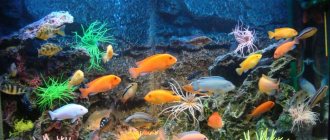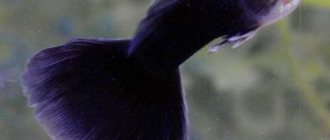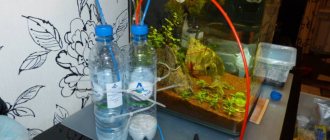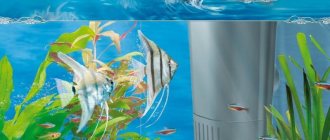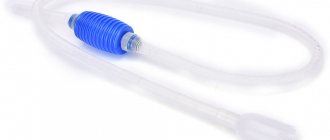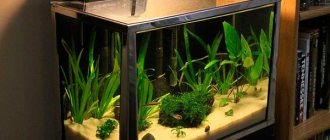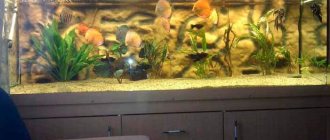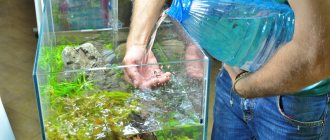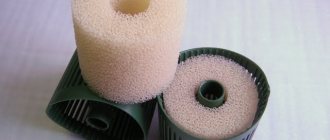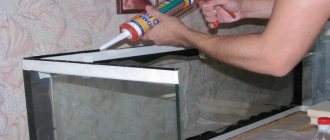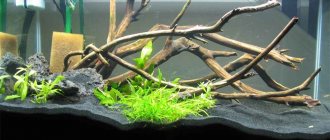Aeration in an artificial reservoir is mandatory. A must for all aquarium dwellers. The exception is fish that breathe surface air. Most aeration devices have the disadvantage of loud sound when operating. This brings inconvenience to the owners if the tank is installed in rooms where the family spends a lot of time. Therefore, experienced aquarists purchase a silent aquarium compressor. There are also ways you can reduce noise levels.
How to use
Disputes often arise in the operation of aerators. Some do not turn off the compressor, others turn it on only after the feeding process. But a more comfortable mode for fish will be a mode of alternating on and off at equal time intervals: operation for 2/2 hours (that is, air flows for 2 hours and the device is turned off for 2 hours) or 3/3 hours. But you shouldn’t take too long breaks, because the oxygen in the water decreases. Turn on the aerator after feeding - fish need a lot of oxygen to digest food.
Purpose of the device
Oxygen, even dissolved in water, is vital for the life of any aquatic organisms. That is why it is necessary to use special devices that forcefully aerate the water, ensuring its saturation with oxygen molecules. This process prevents the death of fish, shellfish and shrimp and ensures the creation of optimal conditions for their living.
Modern compressors are economical to operate. These are completely silent and easy-to-use devices that have the ability to adjust power, which allows them to saturate with oxygen both a small container and aquariums with a volume of 300-500 liters.
Types of compressors
All quiet aquarium compressors are divided into 2 types based on internal mechanisms: membrane and piston.
The membrane type releases air through several internal moving membranes. The air flows in one direction and does not suck water into the device. Diaphragm compressors are characterized by low energy costs and operate almost silently, except for the splashing of water. But this type is only suitable for small tanks with a small population of fish, the volume of which does not exceed 150 liters. Valued as an inexpensive but durable aerator.
Piston compressors operate by having a piston inside, which pushes air through a tube. This species is not as quiet and produces a slight buzzing noise that is not too noticeable. They have a higher price, but are capable of enriching much larger volumes of liquid with oxygen. Low-priced piston devices are often not of good quality. They get quite hot, which will have a bad effect on the fish.
There are devices on sale that do not release air bubbles from the underwater tube, but are located on the surface. They create ripples in the water and constant movement of water, during which the water is enriched with oxygen. But this species is not suitable for keeping bottom fish.
Aerating devices are powered by electricity, but there are also battery-powered ones. Battery-powered aerators are used when transporting fish.
An alternative to a silent aerator for an aquarium are oxidizers. These devices are absolutely silent, because the process of enriching water with oxygen occurs due to chemical reactions. The device contains hydrogen peroxide, which decomposes into water and oxygen due to the action of metal catalysts.
View this post on Instagram
Posted by Products for Fish and Animals (@aqua.dom.laguna) Jul 12, 2016 at 10:08 am PDT
Aquarists also use aquarium pumps. This collar apump device combines the functions of an aerator and a filter - it enriches the air with oxygen and purifies the water. It is most often equipped in large-scale aquariums. The aquarium pump makes little noise due to its complete immersion in water.
Pump manufacturers
Using a pump, you can maintain the necessary microflora in the aquarium. When choosing equipment, you should give preference to leading manufacturers specializing in aquarium equipment:
Eheim. German manufacturer of devices for aquariums. It is a world leader in instruments renowned for their durability and reliability. The manufacturer provides the buyer with a 3-year warranty. Resum. The pumps from this company meet all the necessary requirements. They are highly efficient and virtually silent. The advantage of the devices is economical energy consumption.
The manufacturer Eneim provides the buyer with a 3-year warranty.
Hailea. The company produces devices with low water supply pressure. For easy control of liquid flow, the devices are equipped with a switching regulator. Using rubber suction cups, the device is easily attached to the aquarium. Aquael. Devices from the Polish manufacturer are easy to maintain. Their high efficiency is ideal for water aeration. All models are equipped with a stepless control system, which makes it possible to regulate the flow of liquid in any volume. Tunze. The manufacturer relies on the pump to accurately reproduce the flow structure. They are characterized by good performance, compactness and quiet operation.
Installing a silent compressor correctly
Before installation, locate the compressor and read the instructions. Some models are located directly in the water, others above the surface. External aerators are attached to a table, aquarium lid or special places - shelves. Place at such a distance that the underwater tube is long enough to reach the bottom of the aquarium. The lower the spraying location, the better the water will be enriched with oxygen.
Instances with suction cups are attached directly to the walls of the aquarium, and the outer tube is located on the surface.
It is better to place the underwater tube next to the heater. Air bubbles will immediately mix layers with different temperatures, which will have a beneficial effect on the fish, because the same temperature throughout the entire volume of the aquarium is more beneficial for them.
The solution to the noise problem for some has been remote compressors. The device itself with a long tube is placed away from the aquarium, sometimes even in another room. This provides complete silence when other noise reduction methods fail.
Storm mode
Some pumps for creating current in a saltwater aquarium have a “Storm” function. Unlike equipment that merely simulates this natural phenomenon using LED flashes, advanced current pump models create conditions identical to those that occur on the reef during a storm. The pump increases the flow rate, creating a chaotic movement throughout the aquarium, lifting and mixing deuterium in those places where it accumulates. Upon reaching maximum power, uneaten food, dirt and detritus are thrown into the filter. Then, following the program, the pump reduces power and the storm ends.
DIY silent compressor
It is possible to make a quiet compressor yourself, rather than purchasing it in a store, where prices for devices can be greatly inflated.
It is important to understand the operating principle of the device before operation. During operation, the aerator must first accumulate air, and then release it under pressure through a tube in the aquarium. The chambers of balls, cars, and balloons most often serve as places for air accumulation. Usually these are objects made of rubber, which is slightly stretchable. In addition to the rubber bladder, you will need a small hand pump from a car or bicycle.
To connect, you will need to purchase a three-way tap. These taps vary in size. We need a small tap used for heating systems, and miniature products, for example, for medical purposes. You will also need a tube from an IV, at the end of which there should be a clamp.
How to make a silent compressor for an aquarium with your own hands:
- Attach 3 thin tubes to the pump, rubber chamber, and the third will supply air. Connect everything and ensure tightness.
- Seal the free end and make several small holes in the tube.
- Inflate the rubber bladder using a hand pump, then seal off the path.
- Open the passage from the chamber to the free tube.
- Adjust the diameter of the tube using the clamp.
- Experiment with the amount and speed of air that suits your fish.
Pump selection
An important parameter is where it will be placed and what size the aquarium itself is. External pumps are often chosen, which are installed on the back walls so as not to spoil the appearance
The ratio of throughput and power of the device is also important. The pump will be suitable for the aquarium if it pumps more than half of all the water in an hour
Today you can find pumps for aquariums from different manufacturers.
But how do you decide which pump to choose for your aquarium? It is important that the manufacturer is known in the market, and the price of the device is in the middle sector. A particularly important point when choosing is the noise level that the device will create.
The best compressor model in terms of quality and price
The leader among other silent aerators is Tetra APS. The compressor has sufficient power to work in both small and large aquariums with a volume of 5 to 100 liters. Its high performance is noted, because in 1 hour Tetra APS pumps up to 100 liters. Power consumption is low - only 2.5 W.
Silence is achieved due to rubberized legs and fastenings that suppress any vibration and noise. The amount of noise produced is reduced even more due to the structure of the device.
The aquarist is able to independently regulate the amount of incoming air.
The low price further increases the popularity of the compressor. You can purchase Tetra APS for about 1000–1500 rubles.
Resun
The Chinese compressor positions itself as silent, but test results show a completely different result. Even if the aerator was relatively quiet when purchased in a store, after just a couple of months the volume is 45 dB, plus there is strong heating of the body. In addition, the warranty on most models is only six months.
Chinese Resun has a low price, which is why they attract customers, especially beginners. But the controversial question is whether it is worth saving in such a matter.
Noise reduction options
Even initially silent compressors can begin to make an audible buzzing and noise after a while. This is especially problematic when the aquarium is located in living rooms, bedrooms, or in large aquariums that require powerful devices. You can reduce the noise level at home too.
If the source of noise is the buzzing of the aerator against objects or glass, then placing a soft dish sponge under the compressor will solve the problem. The sponge will absorb noise and buzzing.
For the compressor, boxes are also made for partial insulation from wood or plastic, and the inside is covered with foam rubber.
If this does not eliminate the noise, then open the device without damaging the parts. Usually the noise is produced by the operation of the membrane pressing on the air. Carefully cut or saw off the interfering parts of the membrane and the noise will disappear.
The cause of unnecessary sounds and poor performance of the aeration device is often contamination of the internal parts. To prevent contamination, clean your aquarium monthly. The loose parts are still noisy. To stop the noise, simply tighten the loose parts.
JBL
JBL has a whole “silent” line called JBL ProSilent. Despite their virtually silent operation, their compressors fully provide aeration for aquariums of various sizes (from 40 to 600 liters).
The noise level demonstrated during measurements was 20 dB (if you choose the smallest model) and 30 dB (for the largest ones). The manufacturer also warns that the sound level may increase over time due to dust on the air duct gasket and limescale contamination of the sprayer. However, these spare parts can always be replaced.
Bandwidth
A homemade or factory-made pump for an aquarium must have the necessary throughput. Using this parameter, the water flow necessary to meet the physiological needs of living organisms is created. In simple words, the calculated pumping value of 100 liters of capacity is ensured by a pumping capacity of 300-500 l/h.
According to the established rules, the pump capacity must correspond to pumping five volumes of the reservoir used. According to calculations, the pump should pump 3-5 such aquariums per hour of operation. Proper circulation not only cleans the aquatic environment, but also transfers oxygen there, maintaining a comfortable microclimate for fish and other inhabitants.
